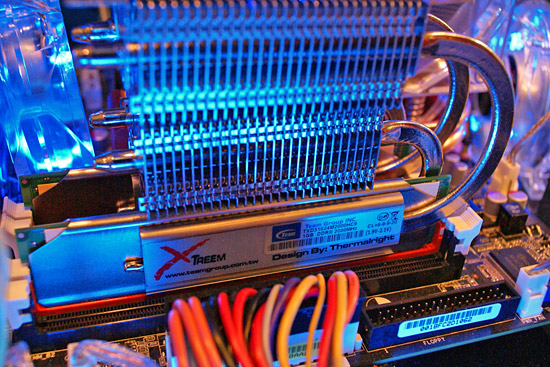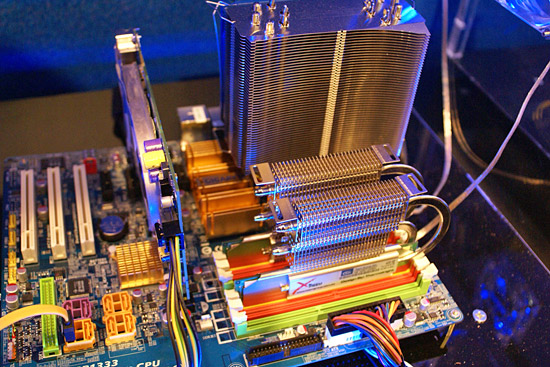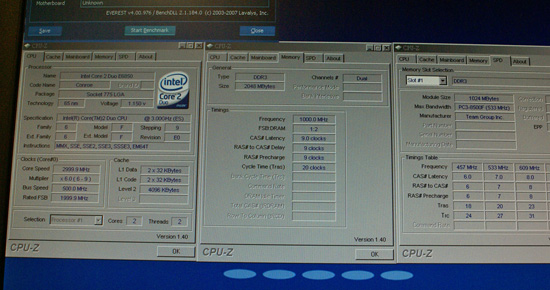Computex 2007: AMD's Barcelona and Other Products
by Gary Key on June 11, 2007 4:00 AM EST- Posted in
- Trade Shows
More Show Coverage
Besides our time spent with Barcelona, we decided to take the last day of Computex and take a last walk around the various halls looking for products or demonstrations that impressed us over the course of the last week in Taiwan. We've got some additional Computex coverage including a few interesting demonstrations behind closed doors, but first we need to catch a flight back home.
In terms of performance or excitement, we have to say that this year's show was again dominated by Intel based products. This is not to slight AMD, but the green team really did not bring its upcoming firepower to the show. This is not because they did not want to, but as we discussed already Barcelona/Agena as well as RD790 are just not mature enough yet to make the same kind of splash that Core 2 Duo did for Intel last year - and that early Penryn/X38 previews are doing to a lesser degree this year.
It would take several hundred pages of coverage to provide details on all of the products on display at this year's Computex. The vast majority of products we witnessed, touched, or tested have already been announced or even released so this year's show was a bit anti-climatic. Still, let's take a quick look at a few products that impressed us before we finish up our coverage and return home.
Team Group
Team Group is a well-known manufacturer of high performance memory and they had several demonstrations at their booth but we found these two to be extremely interesting.

The new Team Xtreme TXD3102-4M2000HC9 is a 1GB DDR3 module rated at 2000MHz. The modules are cooled by a custom Thermalright heatspreader and feature 9-9-9-20 timings at 1.90V~2.1V. This voltage is quite high for DDR3 memory but the modules feature Micron's new 8x128 ICs on a proprietary board design. While there has been plenty of screenshots showing DDR3 memory running above 2000MHz, those have generally been completed with a single module or custom 512MB modules in dual channel mode. In contrast, Team has managed to qualify this 2GB memory kit on the ASUS P5K3-Deluxe in dual channel mode up to 2100MHz.


Team Group also had their new TXDD1024M1333HC5, which is a 1GB DDR2 module rated at 1333MHz (on P35) with 5-6-6-18 timings at 2.35V~2.45V. This memory was installed on a Gigabyte GA-P35C-DS3R board with voltage set to 2.40, E6600 running at 6x400FSB, and the memory set at a 3:5 ratio with the timings listed above. While impressive for DDR2, we will have to wait to test the memory ourselves as chipset and memory strap latencies are fairly reduced on the Gigabyte board at this FSB setting.
Besides our time spent with Barcelona, we decided to take the last day of Computex and take a last walk around the various halls looking for products or demonstrations that impressed us over the course of the last week in Taiwan. We've got some additional Computex coverage including a few interesting demonstrations behind closed doors, but first we need to catch a flight back home.
In terms of performance or excitement, we have to say that this year's show was again dominated by Intel based products. This is not to slight AMD, but the green team really did not bring its upcoming firepower to the show. This is not because they did not want to, but as we discussed already Barcelona/Agena as well as RD790 are just not mature enough yet to make the same kind of splash that Core 2 Duo did for Intel last year - and that early Penryn/X38 previews are doing to a lesser degree this year.
It would take several hundred pages of coverage to provide details on all of the products on display at this year's Computex. The vast majority of products we witnessed, touched, or tested have already been announced or even released so this year's show was a bit anti-climatic. Still, let's take a quick look at a few products that impressed us before we finish up our coverage and return home.
Team Group
Team Group is a well-known manufacturer of high performance memory and they had several demonstrations at their booth but we found these two to be extremely interesting.

 |
| Click to enlarge |
The new Team Xtreme TXD3102-4M2000HC9 is a 1GB DDR3 module rated at 2000MHz. The modules are cooled by a custom Thermalright heatspreader and feature 9-9-9-20 timings at 1.90V~2.1V. This voltage is quite high for DDR3 memory but the modules feature Micron's new 8x128 ICs on a proprietary board design. While there has been plenty of screenshots showing DDR3 memory running above 2000MHz, those have generally been completed with a single module or custom 512MB modules in dual channel mode. In contrast, Team has managed to qualify this 2GB memory kit on the ASUS P5K3-Deluxe in dual channel mode up to 2100MHz.


Team Group also had their new TXDD1024M1333HC5, which is a 1GB DDR2 module rated at 1333MHz (on P35) with 5-6-6-18 timings at 2.35V~2.45V. This memory was installed on a Gigabyte GA-P35C-DS3R board with voltage set to 2.40, E6600 running at 6x400FSB, and the memory set at a 3:5 ratio with the timings listed above. While impressive for DDR2, we will have to wait to test the memory ourselves as chipset and memory strap latencies are fairly reduced on the Gigabyte board at this FSB setting.










64 Comments
View All Comments
Roy2001 - Wednesday, June 13, 2007 - link
Well CobraT1, I think he has NO idea about CPU manufacturing and cost, at all.Barcy would be significant for AMD, but no for PC industry. There is no way it can compet with Penryn. The very first Penryn (1st tapeout) runs up to 3.7Ghz in Intel lab. Even if it can reach 2.8Ghz as AMD simulated, it won't beat Penryn @3.7Ghz.
AMD was/is and will be in trouble. They have to wait until their 45nm process is up and run. Before that, they have no chance.
strikeback03 - Wednesday, June 13, 2007 - link
Well, if your car is turbocharged, 50HP is often just an ECU flash away. If you have a supercharger you can put on a smaller pulley. No guarantee on how well the rest of the powertrain will hold up, but it can be done. The VW 1.8T engines supposedly respond well to just changing the intake manifold gasket. The RB26DETT was reported to pick up over 100HP from just camshafts and an ECU flash.Back to the subject of processors, I agree that the size of the leap over it's predecessor won't matter much if Barcelona can't at least match Penryn. Also, IIRC, Nehalem is scheduled for release next year, which is supposed to be a more significant update. So even if Barcelona outperforms Penryn, AMD can't wait nearly so long to pull their next rabbit out of a hat as they have for this update.
Also, if I were a shareholder of AMD, I'd be concerned that if they do get delayed to the very end of this year or early next year, then the earliest they are going to return a profit is Q3 08. As mentioned elsewhere in the comments, companies don't generally rush out to upgrade their servers, and the majority of consumer purchases are in Q3 and esp. Q4. So if AMD can't have the new processors on the shelves this year, that will be two Christmas buying cycles in a row where they have played second fiddle to Intel. That won't help their bottom line.
CobraT1 - Wednesday, June 13, 2007 - link
I understand what your saying, that it is possible to boost power output of some engine designs, especially designs that were poor to begin with. Yet, the point was to increase overall power without suffering losses, and it being easy. Like with processors, this is generally not a quick and easy task and concessions generally need to be made. It takes proper consideration of usage, limitations, cost and the understanding of how the components will work in concert. With software modifications of engine managements systems (ECU) it is just as easy to reduce performance or negatively effect other operational criteria with programming. Testing needs to be done, hence the usage of dyno's in graphing power profiles and monitoring function. And generally, with no other modifications the power profile will change. Gains will be made under certain speed\loads while losses will be seen under others. Efficiency also generally drops. For example, modifications can fairly easily be made (like throwing on a larger TB) to produce a higher peak hp, yet throttle response, low-end torque and efficiency will generally suffer. That would not be an ideal design choice in regards to what we are analogizing. Induction velocities, capacities, fuel atomization abilities, fuel mixtures, cam\valve timings, valve lift, duration and I\O overlap, combustion chamber size, CC shape, plug choice, Ign. timings, duration and intensity, I\O port shape, size and length, scavenging and\or back pressure, the list could go on and on. The point is, if you change one it effects the others, and like in processor design these components need to be designed in such a way that the hole functions as was intended. If an increase in overall performance and efficiency is the intended target, you generally can’t just add something to achieve this. Even just adding cache in a processor design has it positive and negative impacts.strikeback03 - Thursday, June 14, 2007 - link
I suppose I didn't read that correctly. Yes, if a company wants to add more power they need to research it extensively. However, the consumer can just go buy the results of that research, so for them it is relatively easy.Roy2001 - Monday, June 11, 2007 - link
That's funny comment. Hector has devoted his life to fight with Intel since Motorola days with 68000. But we can forsee he won't make it. CPU industry is not just design or execusion. It's capital/manufacturing.TA152H - Monday, June 11, 2007 - link
Yet, it was design, under Jerry Sander's leadership, that made AMD what it is today. Or was, except Hector now has given up that leadership in design. They waited too long. He was never known as a visionary, but was supposed to help with execution, which hasn't exactly worked, has it?Where is the 68K now anyway? That's a good example of his prowess. A much better processor with a much more elegant instruction set is essentially dead, although Freescale still sells something close to it with a scaled-down instruction set. If the 68K line had the 68008 in time, would IBM have chosen the 8088? Doubtful, since they used the 68K in their 3270 and 370 emulators, not an Intel product. It's not like the 68008 wasn't possible either, it's somewhat simpler in that it has few address lines and data lines. So, where does he deserve credit for this???
tacoburrito - Monday, June 11, 2007 - link
Anyone else thought that Shittle's SFF cases are getting bigger? With their G2 and G5 models, they looked great with their compact designs. Now it seems that Shuttle's cases are simply mid-sized towers turned sideways.erwos - Tuesday, June 12, 2007 - link
Shuttles are a touch larger than they used to be, but let's face it: you just can't cool a modern quad-core CPU and a high-end GPU without a little extra space to work with.They are _nowhere near_ the size of a mid-tower. The SS21T is a touch larger than most, but everything else is far smaller.
Regs - Monday, June 11, 2007 - link
That AMD did not spend 3-4 years of R&D on this processor. More like..6-12 months. They started when they first saw Pentium M or was it when they first saw a Core Duo? I'm thinking when they first saw Core Duo because AMD made die shrinks before without updating the architecture. Though it seems like most of the time in development for the "Bark" has been making it work on a platform.All I got to say is what the hell was AMD thinking? They don't even have their mid-range video cards out yet and that's if you don't all ready consider their "flagship" middle range.
ShapeGSX - Monday, June 11, 2007 - link
That is simply not possible. It takes much longer than that to get a new piece of silicon out the door.